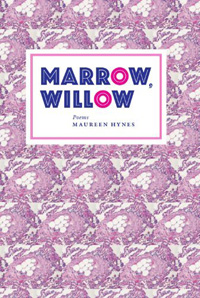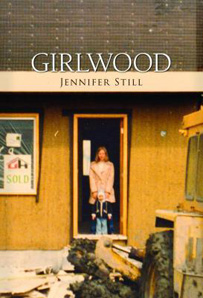Reviews
Poetry Reviews by M. Travis Lane
Maureen Hynes, Marrow, Willow (Toronto: Pedlar, 2011). Paperbound, 104 pp., $20.
Jennifer Still, Girlwood (London: Brick, 2011). Paperbound, 120 pp., $19.
Although both Maureen Hynes and Jennifer Still are technically sophisticated, and share a talent for lively imagery, there is a serious difference between them. It’s a matter of vision. One of the things we want from poetry is to be surprised by our recognition of a truth. Edmund Wilson called it the “shock of recognition.” We like inventiveness; we like a new way of seeing or saying. But if what a poet presents strikes us as inauthentic, biased, or as caricature, we are disconcerted. The poems by Maureen Hynes ring true. Many of the poems by Jennifer Still are caricature.
Marrow, Willow presents to us the life of a mother, daughter, lover, friend—as  tourist, newspaper reader, moralist, artist, poet, comedian. Hynes places her speaker/observer in a world that extends from galaxies to ions, from refugees and the victims of torture to the joys of a fortunate childhood, from sexual rapture to the distress of loss. Hynes’s perceptions and metaphors are never outré, but are often startling in their aptness and domesticity: “Melancholy and joy, each one soaked and felted / with the other, a seamless overcoat” (“Ghazal for Summer’s End”). Some of us may recall that other seamless garment: Hynes knows that this felted togetherness of sadness and joy is the human condition. It is what we bear, what we wear. Many of Hynes’s poems are prescriptive: how to live, perhaps, or how to make a poem, or crabapple jelly, or how to ease a sad heart. Among my favourites of such poems is “Ephemeral,” which urges us: “Each day to make one new thing, gathering the elements at hand: / unsigned, transitory.” The things we are to make of our situation are often a kind of poetry, half way between gardening/housekeeping and painting/poetry: “Stash moss under the slate ledge to soften its shadow,” or “Trace the slow crackle sunflowering a clay wall.” We live best if we live as makers, with creative perceptions, Hynes tells us. But “making” has its law: “Melting and the permanent law/of moisture loss are your tools.“ “Ephemeral” ends by implying that it is not things but our lives that we are making: “melting and loss are your tools.”
tourist, newspaper reader, moralist, artist, poet, comedian. Hynes places her speaker/observer in a world that extends from galaxies to ions, from refugees and the victims of torture to the joys of a fortunate childhood, from sexual rapture to the distress of loss. Hynes’s perceptions and metaphors are never outré, but are often startling in their aptness and domesticity: “Melancholy and joy, each one soaked and felted / with the other, a seamless overcoat” (“Ghazal for Summer’s End”). Some of us may recall that other seamless garment: Hynes knows that this felted togetherness of sadness and joy is the human condition. It is what we bear, what we wear. Many of Hynes’s poems are prescriptive: how to live, perhaps, or how to make a poem, or crabapple jelly, or how to ease a sad heart. Among my favourites of such poems is “Ephemeral,” which urges us: “Each day to make one new thing, gathering the elements at hand: / unsigned, transitory.” The things we are to make of our situation are often a kind of poetry, half way between gardening/housekeeping and painting/poetry: “Stash moss under the slate ledge to soften its shadow,” or “Trace the slow crackle sunflowering a clay wall.” We live best if we live as makers, with creative perceptions, Hynes tells us. But “making” has its law: “Melting and the permanent law/of moisture loss are your tools.“ “Ephemeral” ends by implying that it is not things but our lives that we are making: “melting and loss are your tools.”
Hynes’s ability to perceive the relations between the personal and the impersonal produces some magical poems. In “Dark Morning,” for example, two lovers, waking, endeavour to share with each other their imperfectly recalled dreams—but recollection evanesces and becomes: “the flight / of starlings over the roof, becomes the scatter / of rainfall against the window, / becomes one last press of my body / against yours.”
Many of Hynes’s poems are about serious and grievous matters, that must, even when placed within the framing perspective of history and nature, continue to concern us. Vacationing at a lake, admiring children, and a loon’s well-cared-for goslings, “I return to the photo inside my newspaper; a Beirut family stands on a / rubble pile, slapping at a fire with a rug, all they have left. The loon’s family’s / wholeness, ability to provide. // We wait for the coolness of the August night, till the darkest sky, to canoe / out into silence: full star-show, meteors falling down the sky. Newspaper / folded away hours ago, we lie cradled in the canoe under the night’s / harmless fleeting shrapnel” (“Harcourt Sky with Perseids”).
Memory and loss are what we have to work with—and what we remember is sad, and what we have lost we grieve for. But Hynes allows us to take invasive melancholy with “a little salt”:
I am being treated for low levels of hope;
my doctor is confident, sees progress already.
She has read my poems and my pulses, heard me confess
how I salt my potatoes, pour soy sauce into my rice.
Too much salt, she says, that is a lot of grief—
and I see us collecting the city’s grief,
storing it in quonset warehouses below expressway
overpasses….
For cure, “Treatment” continues, the poet is “taking another day.” As healthily heartening, I think, for the reader, is to take another Hynes poem!
Jennifer Still’s Girlwood presents itself as a realistic representation of the thoughts  and concerns of “girls”—but her idea of girlhood seems to be drawn from the magazines that are in the business of selling consumer goods to adolescents. It is true that girls often think and talk obsessively about personal appearance and boys (and are urged to do so by commercial enterprise), and that a thirteen-year-old might well exclaim to a friend, as the advertisement goes: “Once you wear mascara you won’t be able to stop” (“Cosmetics”). Also true to life are Still’s “Track” poems. The stream-of-consciousness style brings to the foreground those sensations, perceptions, fears, and concerns of which we are normally only partially aware. It is the opposite of directed speech, as in conversation or meditation. Still is very good on an adolescent’s developing awareness of sexuality, although the “boys” in these poems are not distinguishable humans, but signifiers of the male. Still’s “Track” poems represent the “girl” at her most selfabsorbed, sensual moments, and they are moments we can recognize: “backrow badboys Big-League chew your bubblegum jeans as you hula-hoop past the eyes in / home ec stirring more than the creampuff mix and quick-rise batter, after all these years the / last-dance tension in your thighs, his Stairway to Heaven rabbit-foot stiffness pressed to your / looking-for-luck-in-all-the TruthDareDoubleDare-PromisetoRepeat places, tongue tip / testing frozen metal, a silence peeled and spit, red petals in the snow all the way home his four / o’clock touching behind the old brick schoolhouse… (“Track 2”).
and concerns of “girls”—but her idea of girlhood seems to be drawn from the magazines that are in the business of selling consumer goods to adolescents. It is true that girls often think and talk obsessively about personal appearance and boys (and are urged to do so by commercial enterprise), and that a thirteen-year-old might well exclaim to a friend, as the advertisement goes: “Once you wear mascara you won’t be able to stop” (“Cosmetics”). Also true to life are Still’s “Track” poems. The stream-of-consciousness style brings to the foreground those sensations, perceptions, fears, and concerns of which we are normally only partially aware. It is the opposite of directed speech, as in conversation or meditation. Still is very good on an adolescent’s developing awareness of sexuality, although the “boys” in these poems are not distinguishable humans, but signifiers of the male. Still’s “Track” poems represent the “girl” at her most selfabsorbed, sensual moments, and they are moments we can recognize: “backrow badboys Big-League chew your bubblegum jeans as you hula-hoop past the eyes in / home ec stirring more than the creampuff mix and quick-rise batter, after all these years the / last-dance tension in your thighs, his Stairway to Heaven rabbit-foot stiffness pressed to your / looking-for-luck-in-all-the TruthDareDoubleDare-PromisetoRepeat places, tongue tip / testing frozen metal, a silence peeled and spit, red petals in the snow all the way home his four / o’clock touching behind the old brick schoolhouse… (“Track 2”).
However, stream-of-consciousness moments cannot represent a whole human. Where Still represents “girl” in moments of meditation, or apparently talking to herself, not under the immediate stress of a perceived situation and hormonal challenge, the “girl’s” language becomes astonishingly vapid. In “Erasers” and “Cosmetics,” make-up and cosmetics are presented as serious metaphors for making poetry. An impersonal and generic “Mother” is perceived and described entirely in terms of clothes and cosmetics: “baby-dolled, daisychained, herringboned, terry-clothed, mini- / skirted, halter-topped, high-waisted, seersuckered, / Nivea’d, tube-topped, pinstriped, shoulder-padded, cowl-necked, / angel-sleeved, hairsprayed, crocheted, silver-chained // Mother // I platform you’’ (“Mother”).
“Mother” is similarly reduced in “Waistlines.” Even in the ambitious Marlattian poem sequence “Moth,” the “Mother” is imaged only as clothes: “metal eyelets spark / your copper rivets // hips, points of / strain // the small of your / beltchains… ”(“fireside”) and: “wornjean blue / on the edge of / your buckle / the pocket the slimfit / the lowrise” (“imago: dusk”). Otherwise the apostrophized “Mother” has no character, but is wholly unimagined—more a vague noun, a nurturing or criticizing force. Still’s “girl” claims to be measuring herself against or competing with an impalpable, passive, characterless entity. The inauthenticity of such a relationship, and such language, is underlined by Still’s occasionally writing “girl” as “we”: “what will we become?” these creatures improbably ask, in “Sunset.” The worst poems in Girlwood appear to have been written by Barbie: “Teardrop,” and “Hitched” “Bouquet,” “Wedding Cake,” and “Flower Girl” from the “Leaf” sequence. “More fetal than petal more toes than rose more float than sprout / more belief than leaf more she loves me than not more conceal than / real” (“Flower Girl”). In real life “girls” are not as shallow as Still portrays them. However poorly educated and however temporarily obsessed with appearance and male response, they nevertheless interest themselves in social and environmental matters such as kindness to animals, or racism, or bullying at school. Many care about music, or sport. Some hold part-time jobs. Rich or poor, “upper-class” or from “the wrong side of the tracks,” “girls” are more interesting and more interested than Still presents them. In other words, they are fully human.
—M. Travis Lane









